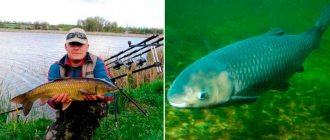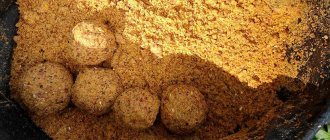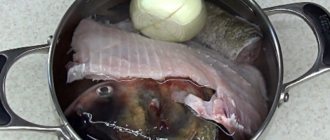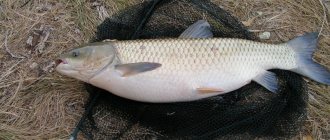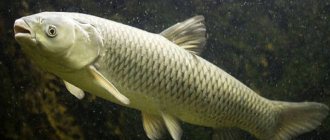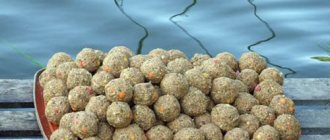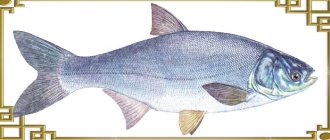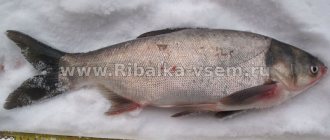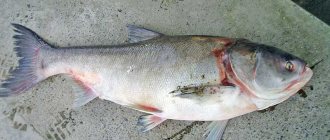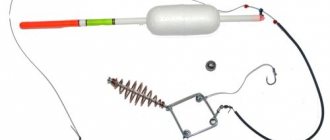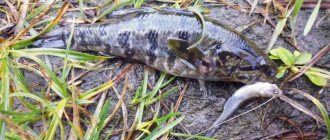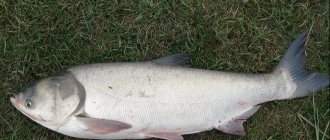Grass carp (lat. Ctenopharyngodon idella) belongs to the carp family.
The only species of the genus Ctenopharyngodon is grass carp.
The homeland of White Cupid is East Asia, it is distributed from the Amur River to Southern China.
It has sharp pharyngeal teeth designed for crushing vegetation.
An elongated body with a low head and a straight mouth, the sides of the body are almost not compressed and covered with dense, large scales, a dark rim stretches along the edges of the scales, the back is rounded, its dorsal fin is slightly short, but high, shifted towards the tail. The caudal and dorsal fins are slightly darker, the rest are light. Gill cover with semicircular stripes. The back is greenish-gray, the sides are yellowish, and the belly is golden.
Cupid grows quite quickly, reaching impressive sizes, with a body length of up to 122 cm, and weighs up to 32 kg.
Most often you come across specimens weighing 3 kg. How to catch trophy fish, watch the video here.
Cupid is a healthy and valuable commercial fish with tasty, fatty white meat.
Schooling and very hardy, it tolerates wintering well and is not afraid of water salinity.
It is found where it has been artificially planted, in places with aquatic plants, irrigation canals, power plant cooling ponds, reservoirs and ponds.
The fish is exclusively herbivorous and is well suited for clearing water bodies of aquatic plants; by eating plants, it, like the silver carp, saves them from overgrowing. The daily ration of eating grass is as much as the grass carp , and may even exceed the weight of the fish.
Overwinters in pits, forming large aggregations, without feeding. At this time, his entire body is enveloped in a large amount of mucus.
The active period is May – October. Amur is caught in good sunny and calm weather from dawn to sunset. The fish is very cautious and pathologically timid, so you need to be quiet in the pond.
When there is noise, the fish moves away from the shore and stops feeding.
Fishing method
It is best to catch carp on a strong but sensitive rod no shorter than 4 m long with a reliable reel that allows the line to move freely. A 0.7mm fishing line and a sharp No. 7 hook are used, with a 0.6mm leash.
The carp is first fed for several days, using dry corn or corn mixed with cucumber; a similar bait is used for silver carp - compare for yourself, see here.
Tender and young vegetation serves as bait: leaves of young peas, clover, milk corn, cucumber ovaries and filamentous algae.
Although they say that cupid is a vegetarian, but not entirely, it also bites on earthworms and bloodworms. The bait is cast a little further from the location of the fish, and then pulled to the expected location of the carp.
tolstolob.ru
Description of silver carp
Silver carp is a large, deep-sea fish, the maximum size of which can reach 150 centimeters in length and weigh about 27 kilograms . There is also documented data on the capture of silver carp weighing over 50 kilograms. This schooling fish has become a favorite of many fishermen due to its impressive size and nutritional value.
Appearance
The sides of its body are uniformly colored silver. The belly can range from silvery white to pure white. On the large head of the silver carp there is a visually inverted, toothless mouth. The eyes are located far on the head and slightly projected downwards.
It differs noticeably from other fish in the wide structure of its forehead and mouth. The weight of the silver carp's head is 20-15% of the total body weight. Thanks to the wide-set low eyes, the forehead looks visually even wider.
Silver carp, instead of the usual mouth with teeth, has a filtering apparatus. It looks like fused gills, similar to a sponge. Thanks to this structure, it uses them as a filter to catch the main source of food - plankton. By introducing silver carp into artificial fish ponds, you can effectively protect it from water pollution and algal blooms. The body of the silver carp is long and, despite its large size, covered with rather small scales.
Behavior and lifestyle
Silver carp occupies the middle and upper depth layers. They can be seen in the waters of large rivers, warm-water ponds, lakes, creeks, and flooded areas connected to large rivers. They can live both in moving water and in standing water. Quiet, warm waters with a slight current are an ideal place for its habitat. The only thing that scares him away is that the current is too fast; he doesn’t stay long in such places. Their favorite places are shallows with a light current, a sandy, rocky or muddy bottom, as well as artificial reservoirs rich in nutritious plankton.
If you want to catch silver carp, you should look for it in quiet backwaters, far from the noise of the city and major roads. Silver carp can tolerate a wide range of temperatures (0 to 40°C), low oxygen levels, and slightly brackish water. At different times of the year, the behavior of silver carp changes.
This is interesting! In autumn, when the water temperature drops below 8 °C, the fish actively accumulate fat. During the onset of cold weather (winter), he plunges into deep sleep. To do this, silver carp chooses deep holes at the bottom of the reservoir.
In spring, the water is filled with detritus and plankton, at which time the silver carp goes in search of food after a long hibernation. To begin with, it examines the depths and only when the water warms up to 24 °C does it rise to the surface.
At this time, the fish, driven by hunger, grabs any bait, risking being easily caught. At the end of May, you can even catch it with a piece of foam rubber or a cigarette filter.
Lifespan
Under favorable conditions, silver carp can live up to 20 years. In conditions of industrial breeding, this is unprofitable, therefore, it is caught for sale after reaching 2-3 years of age, when it reaches the desired size.
Types of silver carp
In total, there are 3 types of silver carp - silver carp, motley and hybrid.
- The first representative is a fish with a lighter color than its relatives. His body size is average. The head occupies 15-20% of the total body weight. This species is a vegetarian fish, as it feeds exclusively on phytoplankton.
- The second representative is a larger individual, with a large head. Its weight makes up almost half of the total body weight. Less picky in choosing food, consumes both phytoplankton and bioplankton.
- The last species is a product of the development of breeders. It has absorbed the totality of the advantages of previous types. Moreover, this species is more resistant to low water temperatures. It has a small head like a silver carp, but its body grows to a large size.
The differences between the species, as we have noted, consist not only in appearance and size, but also in taste preferences. Representatives of different species prefer different foods, which we will talk about in more detail a little later.
Return to content
Lifetime of silver carp
In favorable conditions, silver carp lives up to two decades. In industry, it is not at all profitable to withstand such a long period of time, so they are caught at the age of 2-3 years.
Range, habitats
Silver carp were first introduced to the United States in the 1970s. It has been reported in several locations in the central and southern United States. They live and breed in the Mississippi River basin. Silver carp are native to large rivers in East Asia. The silver carp is a full-fledged inhabitant of the Pacific Ocean, from China to the Russian Far East and possibly Vietnam. They have been introduced throughout the world, including Mexico, Central America, South America, Africa, the Greater Antilles, the Pacific Islands, Europe and throughout Asia outside their native range.
Silver carp were first brought to the United States by an Arkansas fish farmer in 1973. This was done to control the level of plankton in the ponds, and during this period, silver carp was also used as a food fish.
By 1981, it was discovered in natural waters in Arkansas, likely the result of release from aquaculture facilities. Silver carp are spreading rapidly throughout the rivers of the Mississippi River Basin and are being reported in 12 states in the United States.
They were first recorded in Iowa in 2003 in the waters of the Des Moines River, but have also been found in the Mississippi and Missouri rivers. It also took root in the European part of Russia. Afterwards, they began to release it into the rivers of Russia and Ukraine.
Return to content
general characteristics
This freshwater inhabitant received its second name due to its external resemblance to carp. However, it is not its competitor in the food chain and is slightly different in physiology and behavior. The fry of this species feed on zooplankton. As he grows older, he switches to a purely vegetarian diet. Adult fish eat various species. A species is an evolutionarily established set of individuals characterized by a single... algae, as well as wild terrestrial grass. If there is a lack of food in the ponds, it is enough to mow the grass and throw it into the water for feeding. The feeding of grass carp strictly depends on the temperature regime and completely stops at 12 °C and below. The most suitable temperature for it is 25-30°C.
At this temperature it develops as quickly as possible. It is because of this regime that grass carp in the southern regions of Russia are somewhat larger in size than their peers in the northern and central regions. Stocking density of this species is entirely related to the intensity of vegetation on the pond or lake. With significant density, a large number of fry can be released. In the European part of Russia, this representative of freshwater can only reproduce artificially.
Silver carp diet
The silver carp fish feeds only on plant foods; its menu consists of phytoplankton . The most delicious dish for it is blue-green algae, which captures all fresh waters with the onset of heat. Thanks to this, silver carp is a welcome guest in stagnant reservoirs, since eating these algae helps fight the main source of disease in the reservoir.
This is interesting! The diet of silver carp depends on its age and species. These are mainly plant and animal plankton.
The bighead carp is similar in preferences to its vegetarian relative. But, along with phytoplankton, the smallest food of animal origin also enters its stomach. Thanks to such a rich diet, it grows faster, reaching larger sizes than the silver carp.
The work of Russian breeders on breeding hybrid silver carp by crossing the two above-mentioned species has borne fruit. This helped to combine their advantages in one form.
The head of a hybrid silver carp is not as large as that of a motley carp, but at the same time, it has its impressive size. Its menu is also much wider. In addition to plant and animal plankton, it includes small crustaceans. At the same time, its digestive system is adapted to special feed mixtures for artificial breeding.
The most favorable conditions for catching silver carp are considered to be complete calm and warm water. The higher it is, the more actively the fish feeds, floating closer to the heated water surface.
Return to content
Reproduction and offspring
Silver carp were introduced to the United States, specifically Arkansas, in 1973 to control phytoplankton in ponds, wastewater and lagoons. Soon after, they were grown in government research institutions and private aquaculture facilities. By the 1980s, silver carp were found in open waters in the Mississippi River basin, most likely due to the release of spawning fish during high water.
Silver carp reach puberty at 3-5 years of age. The mating period usually begins in June, since at this time the water reaches the most favorable temperature - 18-20 ° C. Cold can damage the development of eggs, so fish look for a warmer place.
It will also be interesting:
- Pink salmon (Oncorhynсhus gorbusсha)
- Common bream
- Rotan fish (Perccottus glenii)
- Fish Asp
Silver carp has high fertility. Depending on the size of the individual, they can hatch from 500,000 to 1,000,000 eggs. The female silver carp carefully places them in thickets of algae so that they can attach. The length of newly born fry is no more than 5.5 mm. They are born within a day after the eggs are laid. After 4 days, the fry is already hungry and ready to eat. By this time, the same gills that are responsible for sifting plankton from water begin to form. Motley and hybrid silver carp switch to other types of food only after a month and a half, while white carp continue to feed on phytoplankton.
Return to content
Natural enemies
It has few enemies, but the silver carp itself can create some trouble, both for some inhabitants of the waters and for the fishermen themselves who hunt for it. In the wild, silver carp can cause enormous damage to native species as they feed on the plankton that larval fish and mussels require to survive. Silver carp also pose a threat to boaters due to their "love of jumping."
This is interesting! Silver carp is a desirable catch for any fisherman. Therefore, their numbers in the wild are small. There are plenty of them in industrial or farm breeding conditions.
Silver carp reacts unusually to sudden noises. For example, hearing the sound of a motor boat or an oar hitting the water, the fish jumps high above the surface of the water. Since these fish can reach impressive sizes, it can be dangerous for the person in the boat. Silver carp can carry many diseases, such as Asian tapeworm, that can be transmitted to other fish species.
Return to content
Population and species status
There are very few purebred silver carps left. At the same time, active breeding of their more resistant and viable relatives is being carried out on the territory of the Russian Federation and active stimulation of adaptation to the conditions of these territories.
In some American states, on the contrary, there is an active fight against these types of fish. None of the silver carp species are listed in the Red Book; there is no specific data on the population of this species.
Return to content
Commercial value
Numerous fish farms are engaged in breeding silver carp. They get along well with other fish, reach large sizes, and also help keep the pond clean, playing the role of natural orderlies. Such breeding is considered very profitable, especially in industrial quantities. The presence of silver carp in a stocked reservoir almost doubles fish productivity.
Silver carp meat is full of nutrients . True, it is inferior in taste to grass carp meat. Silver carp can be consumed even with a gentle diet during diseases of the gastrointestinal tract. The main benefit lies in the rich content of omega-3 and omega-6 polyunsaturated fatty acids. These substances help in the functioning of the cardiovascular system, the development of immunity, as well as the preservation of the natural beauty and youth of the body. Meat rich in minerals and vitamins promotes the production of hemoglobin, enhancing the antioxidant effect on the body.
Silver carp is a unique fish for dietary nutrition for those who want to lose weight. During thermal cooking, it loses some of its calorie content. 100g of the finished product contains approximately 78 calories. Silver carp is rich in protein, and the composition of its fat is similar to the composition of the fat of sea fish. Dishes made from this type of fish are appreciated by people suffering from diabetes. Their frequent use helps reduce blood sugar levels.
Important! This type of fish can carry parasites that cause metagonimiasis when ingested by humans. They look like worms with small spines, 1 mm in size, which successfully take root in the intestines.
When infected and as they develop in the intestine, damage occurs to its mucous membrane. As a result, abdominal pain, diarrhea, nausea and vomiting appear. Without medical intervention, the infection can progress in the intestines for up to 1 year.
Return to content
simple-fauna.ru
What does grass carp look like?
Description of appearance
The body of the fish has an almost cylindrical, slightly laterally compressed, elongated shape. From the outside it looks like a torpedo. The flattened head, small compared to the body, has a pointed, wide mouth. The eyes are located on the sides, almost at the level of the mouth and are surrounded by a golden iris.
The scales are large with a yellowish tint and a dark rim on the widest part. The back and caudal fins are much darker than the pectoral and ventral ones. The back of the fish is greenish-gray in color, smoothly turning into a salad-golden color on the body and a light, shimmering golden color on the belly.
About grass carp
The fish prefers not deep places overgrown with higher vegetation. The main food of carp is the aquatic vegetation in which it lives. It is of great commercial and economic importance, cleaning overgrown settling tanks of thermal power plants, hydroelectric power plants, and nuclear power plants. The fish lives 22-24 years, reaching a size of 120 cm and a weight of up to 35 kg.
How grass carp winters
Heat-loving fish, as the water cools and the vegetation dies before the winter cold, slides into deep holes. Where it becomes covered with a thick layer of mucus and falls into a stupor similar to sleep. In one pit there can be up to a dozen large and even more small individuals that practically do not move, sparingly using up the fat accumulated over the summer.
Habitats
The natural habitat of the carp is the Amur River basin and water bodies of East Asia and China, in which its reproduction occurs naturally. In other cases, it is bred artificially by fish farms. Favorite habitats are shallow, sun-warmed and overgrown with aquatic vegetation, watering rivers, lakes and reservoirs.
Food of grass carp
The river cow feeds on elodea and young sedge. Horsetail, hornwort, water buckwheat and other aquatic plants are constantly present in its diet. During floods, the fish switches to feeding on meadow grass.
Farm fish farms sow fields with alfalfa, clover, and grains specifically for fattening. Which after harvesting go to feed. Grass carp begin feeding on vegetation after the fry reaches a size of 3 centimeters. The juveniles feed most actively at temp. water 20-22 gr. WITH.
Actively eating both aquatic plants and terrestrial ones hanging over the reservoir, the voracious fish is capable of gaining up to 10 centimeters in height in a year. Moreover, he eats more food per day than his own body weight.
Spawning
Having reached 7-10 years of age, young carp become sexually mature. Spawning of grass carp in the natural environment occurs on the current in places where rivers have a sandy bottom. Current speed is from 1, but not more than 3 m/s. Most often, the process occurs during floods, after summer rains. The optimal water temperature is 26-30 degrees. Before spawning, males develop a mass of white tubercles on their pectoral fins. Depending on age, the female is capable of laying from 300 thousand to 1.2 million eggs.
The development of eggs lasts 32-40 hours depending on the water temperature of 27-29 degrees. After 7 days, the hatched fry reach 8 mm in length and begin to move to the calm waters of oxbow lakes, backwaters and bays where there is plenty of food supply.
Since rivers with the characteristic features of the Amur are not found in the west, ichthyologists have learned to create artificial conditions similar to natural ones. For reproduction, special chambers are used in which females are injected with a hormone to develop eggs. In the warm waters of the southern regions of the Volga, Kuban, and Danube, grass carp learned to reproduce without human help.
Peculiarities of breeding white Amur
Reproduction of “grass carp,” as grass carp is also called, has a number of undeniable advantages.
- Significant growth rate.
- Reaches a weight of 32 kilograms.
- The meat has excellent taste.
- Low oxygen requirements.
- Low susceptibility to infectious diseases.
- Participates in natural water purification.
Grass carp gains marketable weight in a very short time. Given the correct growth conditions and successful breeding, it reaches a weight of 800 grams at 2 years of age. Three-year-old individuals grow up to 1500 grams, and four-year-olds up to 3000-3200. This is one of the fastest growing representatives of the marine fauna of East Asia, which gives it high fishing potential.
Another important factor is that adult fish can reach a mass of 32 kilograms and grow more than 120 cm. This fact attracts sports fishing enthusiasts and makes it possible to receive additional profit from fishing. The culinary characteristics of this representative of cyprinids are also highly valued. Its white meat is distinguished by its high density, fat content and pleasant taste. Low requirements for the O2 content in the water will reduce the likelihood of the death of a flock due to low aeration.
This species is an evolutionarily established set of individuals, characterized by a single... cyprinids have a fairly high immunity and resistance to diseases, which increases profitability due to the relatively low pestilence. The ability to feed on huge quantities of aquatic vegetation gives it another irreplaceable advantage. Stocking reservoirs, reservoirs and cooling power plants with fish makes it possible to combat algae with significant efficiency. Adult representatives can eat an amount of vegetation that exceeds their body weight by 1 and even 1.5 times.
Fishing for grass carp
Catching grass carp in summer is not an easy task, since this representative of carp feeds exclusively on aquatic vegetation, which grows in large quantities in summer. In addition, he is very timid and at the slightest danger he even moves away from feeding areas.
In cases where the desire to catch a river cow exceeds common sense.
They resort to the following methods.
The weather should be warm and calm, the water temperature should be at least 18 degrees. Gear is selected based on the characteristics of the reservoir. The best option is a plug, then a feeder, a match rod.
Plug
- To catch a large specimen, use poles of at least 13 meters. The rubber shock absorber selects, depending on the thickness of the fishing line, 1.4 - 0.14, 1.6-0.16, 1.8-0.18, etc. Hook No. 10 is knitted directly to the fishing line. This rule applies to any fishing method. In order not to spook the fish, the bait is lowered slightly to the side of the baited area and throughout the entire fishing, move it slightly, swinging the rod.
Feeder
- A special feature of fishing with feeder gear is a floating paternoster feeder inside, into which foam plastic is inserted to hold it on the surface of the water. The food is slowly washed out, attracting fish in a column of turbidity. Feeder gear uses braided line, which will allow you to catch large fish.
Match rod
- A match rod is excellent for fishing for grass carp if you equip it with a reliable reel and braid with a diameter of 0.5 mm. Hooks for the match are selected No. 2-4 according to M.K.
Nozzle
For bait, you can use traditional bait: cucumber cubes, dandelion stem, cabbage leaf, bean or pea pods. Cupid loves tiger nut very much. Currently, they are successfully caught using boilies, pickled corn, and steamed wheat.
If juveniles can also bite on a worm, then a large specimen can be caught exclusively with plant bait. Before attaching, cut the cucumber into small cubes, take bean pods and peas that are not hard with barely emerging grains.
Cabbage
The cabbage leaf is taken closer to the middle and cut into strips along the vein of the leaf. Place an accordion on the hook, leaving a small 5 cm hanging tail. What’s good about catching carp is that once you get to a body of water without bait, you can use ordinary aquatic vegetation on which it feeds, and its appetite is excellent: 1 kg per 2 kg of fish weight.
Reed
Young shoots of reeds are also excellent. To catch grass carp on reeds, you need to know how to bait it correctly.
A bunch - several leaves 7-12 cm in a quantity of 6-10 pieces, tied into a bunch with another leaf. The bundle is placed on the hook so that the sting points outward. Accordion - the sheet is rolled into an accordion with a side of 2.5-3 cm and put on the hook with the tip facing out. The length of the folded sheet on a hook with a leash is 7-10 cm.
The reed leaf should look like one that has just fallen from a branch and floating on the surface of the water. To impart buoyancy, use a small foam ball tied at a distance of 8-11 cm from the bait.
The best time of year for catching grass carp is considered to be the autumn months of September and October, until the water cools below 12 degrees and the fish go to wintering pits.
What grass carp bite on in the fall.
So, with the onset of cold weather, the grass settles, the food supply becomes scarce, and the fish are more willing to take the bait offered by the fisherman, which are also used in summer fishing. In essence, autumn fishing differs from summer fishing only in the search for fish. In the fall, it is alleviated by the fact that the fish begins to abundantly secrete mucus, which floats in threads on the surface of the water, revealing the location of the object of hunting.
Lure
The voracious river cow is very fond of abundant bait, for which they take grain corn as bait, or crushed, boiled and mixed with coriander.
Corn baits are prepared as follows. Porridge is made from 1 kg of corn or coarsely ground grain. A 10-15g bag of coriander is added to the hot porridge, everything is mixed and the pan is wrapped in a blanket for about five hours for steaming. During fishing, the porridge is simply scattered over a decent area at the place where the gear is installed. You can add pearl barley, overripe bananas, and honey for sweetness and aroma.
Something new in fishing for carp and silver carp
It's no secret that carp and silver carp are not ordinary fish. Their homeland is the Amur basin, but they are introduced into our rivers, lakes, reservoirs and ponds as a valuable fishing object, as well as for the purpose of clearing reservoirs of aquatic vegetation, which these fish successfully cope with. These types of fish reach impressive sizes (up to 20 kg) and, naturally, are of interest to anglers. Cupid even earned the right to be a qualifying fish in carp competitions. There are white and black carp, as well as white and bighead carp. I should note that, despite the prevailing stereotypes about the possibility of catching these fish only in the upper layers of water in the hot summer, in the Odessa region we regularly catch carp and silver carp using bottom gear (from the bottom). The topic of catching these fish has been covered more than once in periodicals. I’ll make a reservation at the beginning of the article that I mainly catch carp and silver carp in closed reservoirs (lakes, canals, estuaries...) All reservoirs are different, so there are different approaches to fishing gear and methods. The main condition for successful fishing is a large concentration of silver carp and grass carp in the reservoir. Silver carp.
Silver carp feed mostly on plankton. It is best caught from mid-July to September. Most often they are caught using the gear known to everyone: a stick with technoplankton. Walking silver carp are easy to spot in a pond, as they walk in groups of several individuals near the surface of the water. It is in these areas that you need to be positioned for fishing. They offer float tackle, with a release of no more than 40-50 cm from the surface. The leader is made from soft and strong carp leader material, the hook is quite large with a short shank. Float equipment is loaded in different ways, but I use a self-loaded carp float of such a carrying capacity that when a barrel of technoplankton is put on, the antenna is visible at a great distance, and when the plankton gets wet, the float rests on the water. This makes it easier to observe when you need to reload the tackle. It’s not worth special attention to accurately sinking the float, silver carp is not a crucian carp or a carp, it either took it (the float sharply goes to the side, under the water and you can hear the clutch), or it didn’t take it. This applies to fishing in the water column.
Provided that the reservoir is shallow (up to 2.5-3 m), silver carp can dive for the bait and to the bottom. The bottom equipment can be with the same technoplankt on a stick, or a spring-feeder, but be sure to put a foam ball on the hooks of any bottom equipment for silver carp! Now let's talk about cupid. Grass carp can be successfully caught using regular carp gear. My teammates and I from the Odessa Fishing Club came across cupids that caught canned corn, a technoplane, a worm, and even a mole cricket. However, most of the cupids were caught using a bottom rig with a feeder into which bait was placed; the bait was a foam ball on a hook. In this regard, we use all kinds of feeders. The bait should be chosen with small fractions, based on grains, sunflower cake dust or corn flour. Being at the bottom, the bait must produce an abundant cloud of turbidity, but not dissipate too quickly. These mutually exclusive requirements for bait did not allow for normal fishing for a very long time. Light bait for white fish was quickly eaten by small fish, and large fish did not have time to approach the tackle. The bait was too “oaky” in the water for a long time, but it only attracted carp. The solution was found through trial and error by many anglers. This is a certain ratio of small and large fractions, with the addition of dry milk, but... The bait should seem to be bubbling at the bottom, breaking up into pieces, small particles of which should rise up from the bottom, or be suspended at the bottom. Previously, we achieved this effect by mixing citric acid and soda into the bait, or by inserting an Alka-Seltzer tablet into the spring. Citric acid + soda change the smell of the bait due to a chemical reaction and require the correct dosage, since an excess of them causes the bait to quickly dissolve, and an insufficient amount does not attract fish. Now my colleagues and I have switched to using a special additive in groundbait in the form of a powder known as OXYGEN.
Cupid and silver carp rarely take a bulky bait placed directly on the hook. This is dictated by the peculiarities of their diet. Under normal conditions, these fish often filter the water, feeding on algae and plankton. Only during periods of active feeding and lack of food can cupid and silver carp be taken specifically to one or another bait. This is very important to know and understand if you want to consistently catch these fish. Unlike previously used artisanal additives, OXYGEN produces oxygen when exposed to water! This is very important during the hot summer months when all fish experience oxygen starvation. In addition, with the help of the resulting bubbles, bait particles rise above the bottom, which is very popular with both cupid and silver carp. I know of two varieties of OXYGEN: regular colorless (white powder, does not change color in water) and fluorescent green (orange powder, becomes bright green in water). If you look at the dissolution process of this additive in clear water, it is very similar in appearance to “ blooming water."
I think many anglers have encountered a “water bloom” in the midst of summer; it is the presence of blue-green algae that gathers many silver carp near the surface! Now how to properly use OXYGEN in the fishing process. The most common mistake when using this additive is adding it directly during the preparation of bait. If you add OXYGEN to dry bait, and then add water and start kneading, the reaction will begin in the mixing bowl. After you have mixed the bait you are using, adding water from the reservoir where you catch it, you need to prepare balls approximately the size of your fist. Before use, you need to make a “pancake” out of the ball and place it in the center of the bait spring. We put a foam ball on a long leash with a hook. It is possible to use several leashes. If during the fishing process you need the process of disintegration of the bait ball to begin immediately after lowering to the bottom, you need to use wire or a ballpoint pen to make holes in the bait ball all the way to the spring. Then water will quickly enter the additive through these holes, and the decomposition process will begin immediately. Sometimes, when carp or silver carp are already attracted to the fishing spot, there have already been bites and I need to catch the fish as quickly as possible while it is in the fishing zone, I mix the bait balls immediately with OXYGEN. To do this, I take out the required amount of mixed ready-made bait, add the additive and knead the ball, which I hammer into the spring. I'm making a cast. At the same time, the bait begins to “bubble” all at once, throughout the entire volume, which is immediately noticeable. is biting. I note that both cupid and silver carp are very worthy opponents when fishing. Gear must be reliable and strong. Be sure to release the reel clutch after casting. I use regular carp gear, even when fishing with float gear. Be prepared for sharp turns and “candles” when landing silver carp.
When fishing for cupids, try to keep them on a “short leash” and not let them run wild, especially near snags, reeds and other obstacles. Good luck in hunting for trophy carp and silver carp!
Fish farming
Reproduction of grass carp in an unnatural habitat is very difficult, for this reason it is bred in special fish farms. The farms create favorable conditions for spawning, similar to natural ones. That is, the water temperature is 26-30 and there is an artificial current.
To stimulate mature fish to spawn, injections from extracts of the pituitary fluid of crucian carp or crucian carp are used. The male is injected with 2 mg, the female 4. The first dose for the female is 10%, the second after 3 hours is 90%.
The next day, the caviar and milk are carefully expressed into a wide bowl. Mixing is done with a goose feather so as not to damage the sensitive caviar. Then the boiled caviar is washed with water from the pond in which the fry will develop and grow. The water is drained and the fresh water is carefully stirred until the eggs begin to swell. To equalize the temperature of eggs and water, the container must be lowered into the water of the pond or aquarium.
After an hour and a half, the swollen eggs are placed in a Weiss apparatus, where in running water at 0.5 liters per minute they continue to increase in size for 4 hours. About 70% of the eggs survive to hatching. After the fry hatch, the dead eggs and film should be removed. The surviving fry are transplanted into cages with a mesh size of 0.8-0.9 mm. And the bottom is tense and does not have folds into which the young could slide and suffocate from lack of oxygen.
The cages are placed either in a special pool or in a pond with a weak current. The first 3 days the larvae are kept at a temperature of 22-23 degrees, the next 5 days 23-25 and at 30 degrees for 3 days. Usually this time is enough for them to start swimming in a horizontal position and actively feeding on zooplankton. Then they are released into the pond. Little cupids can be fed with egg yolk, ground with cottage cheese and daphnia.
Enemies
The fry become easy prey for insect larvae, worms and bedbugs, as well as other fish, so the pond in which the larvae will grow should be drained, cleaned, and only then the fry should be planted. Ponds measuring 100 by 200 m2 are well suited for growing.
Grass carp grow quickly and after a month reaches a size of 2-3 cm. After which they are transplanted into juvenile ponds with an area of up to 5 hectares pre-filled with water. The fish are fed with fry food using feeders. Positive feeding is considered to be food eaten within 8-10 hours. Growing grass carp at home cannot do without the best bait: finely chopped soybean meal. Which does not sink for up to 40 minutes. The fry are fed and raised not only in ponds, but also in artificial reservoirs - round concrete pools.
How to breed at home?
This representative of freshwater reproduces naturally only in the conditions of its typical habitat. The fundamentals of industrial reproduction were developed by scientists from Russia and Japan. Females ready to spawn are kept in optimal temperature conditions. The best option for breeding are ponds with a high algae content and reaching optimal temperature values (25-30°C) in the spring-summer period. The algorithm for breeding adults of this species includes the following stages:
- Fertilization and incubation.
- Hatching.
- Feeding the larvae.
- Raising fingerlings.
- Feeding young grass carp.
- Feeding adult grass carp.
At one time, females bring about 500,000 healthy eggs. Taking into account the low productivity of seed material, material from two males is used to fertilize one female. Fertilization produces a high level of waste of living material. Thus, out of 500,000 eggs, only 100,000 fingerlings survive.
This representative can spawn only when the water reaches a temperature above 20°C. As was said, grass carp will not spawn in ponds, even if they have a high flow rate. You should resort to additional manipulations to breed it. To do this, before spawning, females are separated from males and carefully examined for the beginning of spawning.
The eggs and seed substances develop quite normally in them. But for the fertilization stage itself, so-called pituitary injections are used. The introduction is carried out in two stages. On the first, a preliminary injection is performed, on the second, a final injection. The material for administration can be extracts from the pituitary glands of carp or crucian carp. Following the first injection, females and males are placed in a pond with running water. After one day, a second injection of the material is made, after which they are placed in a less flowing environment. After this, I collect the caviar by normal straining.
Fertilization
Eggs from one female 4-5 years old are mixed with 5 ml of male seed material. You should mix the caviar very carefully, as it can quickly become damaged. Most often a pen is used for this. After mixing, water is added to the contents in a ratio of caviar to it of ½ and washed up to 10 times. After constant washing, the caviar swells significantly. She is then placed into Weiss' device. Due to all the manipulations, up to 30% of the eggs die.
Hatching
After hatching, the larvae are placed in nylon nets, which are installed in artificial pools or reservoirs with low currents. Larvae require a specific regime. For 6 days, the temperature must be maintained at 21°C, the next 4 days – 23°C, then 2-3 days – 30°C. If the technique is followed correctly, the larvae take the correct position in the water and begin to feed.
Feeding the larvae
In reservoir conditions there is not always enough plankton for normal nutrition of the larvae. For this purpose, various feeding options are used. As a rule, mixtures of crushed egg yolk and cottage cheese are used. The larvae are often eaten by insects and other small inhabitants of water bodies. To do this, you need to thoroughly clean it before diluting.
Raising fingerlings
For this purpose, special small-volume fry ponds (up to 200 m2) should be used. After the fry reach a size of 2-3 cm, they are transplanted into a larger container (from 500 m2). Young individuals are raised in water areas with the following calculation: 250 larvae or 45 fry per 1 m2.
Feeding the young
Fingerlings are fed even if there is a sufficient amount of plankton. After being placed in water at the age of 5 days, soy mixtures or special fry feed are used. Feeding is established once a day with the obligatory fixation of food mixtures on the surface of the water to prevent drifting by the current.
Feeding adults
Adults, as a rule, feed themselves only with plant foods. When the nutrition level decreases and in case of high stocking, special feed is used. For full growth, you should keep no more than 1-2 individuals per 1 m2 of moderate vegetation. Also, for additional nutrition of adult representatives, you can use ordinary terrestrial vegetation. If you consume a large amount of algae and their population decreases, as well as with a seasonal lack of food, you can simply throw mowed grass into the pond. Adult fish need to be fed about 4 times a day.
To reproduce this species, you can use not only natural reservoirs, but also special fully mechanized complexes with plastic pools and an aeration and water pumping system. This simplifies care and fishing, and reduces the likelihood of infection. However, significant funds will need to be spent on compound feed, which is not required in ponds with sufficient vegetation.
Preparation
Excellent fatty meat is perfect for any fish dishes. It is fried, boiled, smoked, salted. Like all white fish, white carp has a lot of bones, which cause inconvenience when eating. But since they mainly catch large ones, the bones in it are large, which are easily removed.
Consumers who have had tasty and healthy fish, such as carp, in their diet have appreciated the advantages of this type of carp. Cooking fish begins with cutting it. Which goes the same way as usual. Regardless of what dish will be prepared, with the exception of smoking and drying. The carcass must be cleaned of scales, since the fish has thick meat and must be cut into portions.
Useful properties of grass carp
The beneficial properties of the river cow have been known for a long time, including the ability to clear water bodies of vegetation, thereby increasing the area for more fish.
On the gastronomic side, fish meat contains many beneficial microelements for humans, magnesium, sodium, calcium, and phosphorus. Vitamins of group B, as well as A, C, E. Calories kcal calorie content is 135 kcal per 100 g. meat. Eating fish dishes is recommended for patients with cardiovascular diseases, poor metabolism and diseased skin.
ribkaklui.ru
I saw carp and silver carp exclusively on store shelves and on my table. I can’t even say this about grass carp. Or I just don't remember. And so…
As usual, on the first day after our arrival, we went for a walk in the park. Feed the ducks and pigeons, of which there are always a lot here.
Well, at the same time look at the fish that live in the upper pond. And there must be a lot of fish there. I didn't see her last year. And local residents say that it appeared only this year.
Walks in schools or flocks. Who likes it more? I assumed that it might be a silver carp and I was not mistaken.
The fact is that fish were released into this pond back in 2008. I wonder where she was hiding all this time? “Andrey Sulyaev, administrator of Park Kultury LLC:
— In 2008, 500 silver carp and White Cupids were released into the pond near the Circus and Diorama in order to clean the ponds from algae contamination. Over the past two years, there have been significantly more fish in the ponds; there are even large carp.”
Of course, fishermen also appeared. True, I didn’t see them yesterday. They say the main fishing takes place in winter.
“There are more and more fishermen, they come here with fishing rods, swamp nets, and nets. Everyone wants to catch a meter-long silver carp for free. Of course, catching such fish is not easy, but this place is not intended for fishing. We specially installed information boards on both reservoirs. Everything is clearly marked there - fishing, even with a fishing rod, is prohibited here! But the number of fishermen is constantly growing..."
By the way, there are no laws prohibiting fishing in ponds.
They say that the stocking of the reservoir was paid for by one of the largest entrepreneurs in the Kirov region, Valery Vasilyevich Krepostnov. He began his career in 1983 in the city of Magnitogorsk in the Magnitostroy Construction and Installation Trust, as a 2nd category carpenter. He owned a stake in the Doronichi agricultural holding. Currently he is carrying out a number of his own projects: he is the owner of the publishing house "Krepostnov", he is the creator and investor of the Museum of the History of Chocolate "Criollo", which is headed by his daughter Ksenia Larina, according to unofficial information, he owns the newspaper "Komsomolskaya Pravda" in Kirov, sponsored the opening of Alexander's office Herzen in the Regional Scientific Library named after. A.I. Herzen
So today at breakfast, from time to time, thoughts popped up... Should I buy a fishing rod? )))
atlanta-s.livejournal.com
Silver carp and grass carp are ameliorators of water bodies.
Silver carp.
Along with grass carp, silver carp can be of great benefit in overgrown reservoirs, acting as a land reclamation agent. It feeds mainly on microscopic algae - phytoplankton, of which there is a huge amount in our reservoirs in the summer.
Silver carp is a valuable commercial fish that can easily be acclimatized. This is a large fish, up to a meter long and weighing up to 8 kg or more.
Its back and upper part of its head are greenish-gray, its sides and belly are silvery. The dorsal and caudal fins are colored the same as the back, the other fins are light, slightly yellowish.
Silver carp grows quickly. By the end of the first year it reaches 12-13 cm, in the second 25-26 cm, and in the sixth year more than 50 cm. Silver carp lives in schools.
Silver carp easily acclimatizes even in areas very far from its habitat. It is resistant to a dangerous disease of many cyprinids - rubella.
Silver carp grows well together with carp, tench, sterlet, silver carp and other fish. Silver carp, along with cyprinids, is the most important object of pond fish farming.
Joint breeding of silver carp and white carp
The possibility of breeding fish in one environment using a combined method deserves special attention. One of these for white Amur is the silver carp. The difference in diet allows them to be successfully raised in joint water areas. It is worth noting that there are significant differences in the diet of white Amur during the season on ponds and lakes in most of Europe and Asia. This is due to the cyclical growth of certain algae that it feeds on. Silver carp uses phytoplankton in its diet, which allows it to more easily tolerate seasonal changes in the availability of food. The difference in the diets of these two representatives allows one to avoid food competition. Such a successful symbiosis makes it possible to keep not only them together in the same environment, but also to add other fish. These advantages are often used to rationalize fisheries and produce more profitable enterprises.
Another possible symbiont for these representatives of freshwater is carp. It also does not have food or other competition with them, which makes it possible to build more complex systems of cohabitation for these species.
